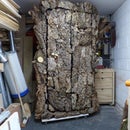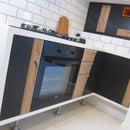Introduction: Tension Series - Garden Bench
Following on from my Floating Bed, here's my latest prototype furniture piece... Portal Bench. A seating bench made for interior or exterior use.
An off-axis loop connects to two legs, each of which is hand carved (with some help from an angle grinder) into a flowing shape. Steam bent feet and slats add to this aesthetic. The seat top balances above the loop thanks to tensioned cables at either end and a thin strut.
The bench was produced in European Oak allowing interior or exterior use and finished with a combination of oil and blue stained highlights.
The bench measures ~1600mm long, 450mm high and 300mm wide.
For this project I decided to film the process... so hopefully giving you a better idea of the steps I took.
Main tools/consumables I used:
- Saws - hand, circular, jigsaw and mitre
- Router
- Angle Grinder with a wood carving disc
- Drill
- Spoke-shave, chisels
- Clamps
- Measuring Equipment
- Drainpipe/ wallpaper steamer
- Exterior wood glue
- Sand paper, wood dye, oil etc
Materials:
- European Oak - good for bending and exteroir use
- Aluminium tubing
- Galvanized wire rope and hardware
Step 1: The Design
In my original sketch for this bench the loop was centralized, which would have allowed the top to be supported solely by the tensioned cables... But as usual the "wouldn't this be cooler if..." part of me got involved and I ended up offsetting the loop by quite a bit.
As the project draw to a close and I start testing it, it became apparent that there was a bit to much cantilever involved. It was able to support me sat on the far end but it just didn't feel robust enough.
I therefore ended up adding a thin bit of steel rod to give it a bit of additional support (always got a backup plan..) I was able to get away with a diameter that's thin enough not to take away from the focal point, the loop.
I've attached the cut list for the main components (for the legs you'll need to cut multiple times that to glue up to the required thickness) and pdf's of the rough templates I worked from. These were printed out full size and give a pretty good starting point...
Update:
So the bench has been in use a couple weeks now and I've noticed something I'll probably have to rework.. The steam bent feet are relaxing and becoming flatter, which is making it hard to keep the stability rigging tensioned. A different way to do the feet is a good idea if you're planning on doing something similar.
Also as commented, just relying on glue for the loop isn't the best idea. I didn't have the tools available but a biscuit joint or something between segments would be better...
Step 2: The Loop
I started off by cutting a plank down to about the correct width for the segments that would make up the loop. To work out the width, you need to know how many segments you're using and the diameter you want the loop to be. From the diameter, work out the circumference and then divide that by the number of segments. This will give you the width of the segments.
The segments were then cut to length. I wanted the loop to taper so the segments reduced in size but they could be the same length. The segments then needed to be mitred on the edges, I was using 18 segments, so needed a 10° mitre on each edge to make up 360°. I made a jig with a stop that was set to the required width away from the blade, this meant each segment could be easily clamped and mitred preciously to the required dimension. If you've got a table saw, that would be better!
The segments were then glued together, with ratchet straps to compress them while drying.
Once dry, an angle grinder with carving disc was used to start making the outside round. A combination of this, a spokeshave and sander were used until I was happy with the 'roundness'. I then used a compass to follow the outer diameter and mark a line for the inner diameter to work to. Again, worked until I was happy with the shape.
Two slots for the legs were then cut by drilling two holes and cutting out the middle with a jigsaw.
I ended up putting a bit of a curve across the width of the loop aswell..
Step 3: The Legs
I started by cutting out the rough profiles of the legs based on templates from my CAD. For the longer leg I had to join two bits of timber together to get the length required, a mortise and tenon was used for this.
The timber I was able to get wasn't thick enough for what I needed, so multiple pieces had to be glued together.
The hard task was to to shape the ends of the legs to fit snugly into the slots I'd cut in the loop, whilst also fitting to the outer diameter of the loop. I started by cutting some card templates to fit into the slot and then using chisels, files and a bit of patience, eventually got a pretty nice fit.
Now the fun bit, shaping the legs. The curves/lines to work to were drawn on... I just worked this out as I went along to get a shape I was happy with. The carving disc I used is made by Kutzall. Its really effective at removing a lot of material quickly and its what I used to rough the shape in. After this it was onto using a spokeshave to refine the shape, quite a bit of work but I'm happy with the result.
Step 4: The Feet
I wanted to incorporate steam bending into this project as its something I've not used before. I went for pretty subtle curves for this first attempt.
I first made a bending form out of plywood. A router was then used to plane the timber down to the required thickness ~20mm. I made a jig to support the router above the plank, you can see how this works pretty well in the video.
My 'steam box' is made from a bit of drainpipe wrapped in packaging insulation foil (to keep the heat in) and a wallpaper steamer is used to produce the steam. The timber was put into the steamer for about an hour, after which it was immediately put into the form and clamped up! Its crucial to do this quickly before the wood starts to cool down. After a night in the form, it was removed to allow the second foot to be bent. The feet were ratchet strapped for a further few days and left to settle while I got on with other things.
The join to connect them to the legs was then cut. The depth stop on the mitre was was engaged to produce a recess that was then cleaned up with a chisel. The feet were then glued to the legs and the legs then joined to the loop.
Step 5: The Seat Top
Another plank was planned down and cut to the required width. 4 equal sized pieces for the slats and a slightly wider piece for the central spine.
The curve of the spine was sketched on and then cut using a jigsaw. Notches were cut for the cross members and a hole for the pivot pin drilled. The cross members were then cut; corresponding notches cut to join to the spine and others for the slats .
More steam bending was used to bend the slats into the same curve as the top of the spine. Again a simple form was knocked up in some scrap sheet wood I had and the individual slats clamped to this. Once bent the slats were moved to a cooling jig.
Once all the slats were bent and recesses cut, the top was glued together and clamped
Step 6: Finishing & Assembly
Everything was then sanded down and I used some blue wood dye to colour particular parts. An outdoor furniture oil was then applied to seal the wood, 3 coats in total.
The top is sat onto the loop and an aluminium pin inserted to join them. A thin rod was added at the end of the offset side and cables then tensioned up to prevent rocking/play.
The last thing was to add some pieces of rubber to the underside of the feet and it was finished!
The finished bench is very stable and functions as intended.














